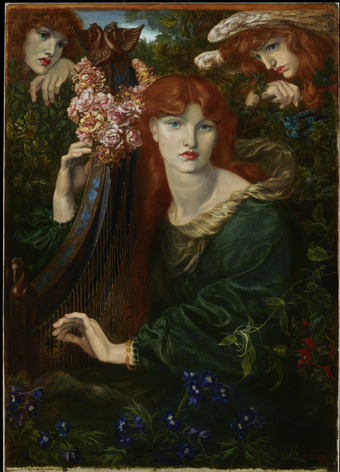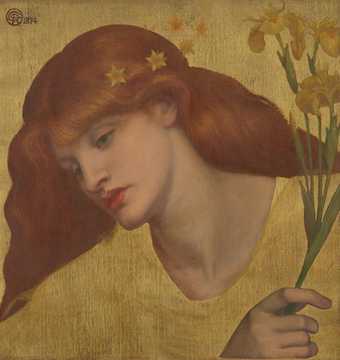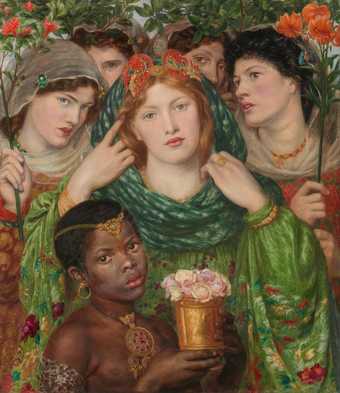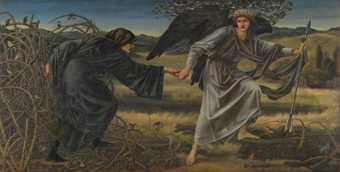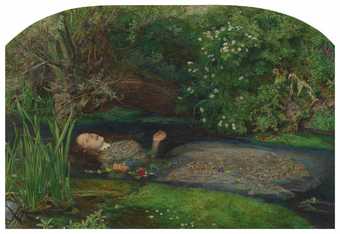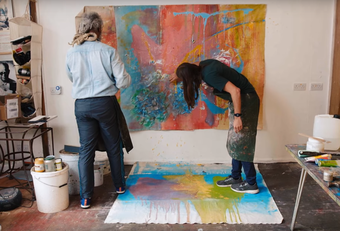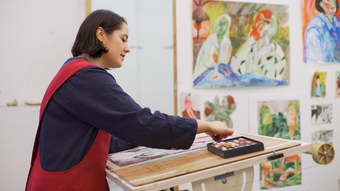Hi my name is Glory. I'm an artist, and today I'm going to be teaching you how to paint a flower like a Pre-Raphaelite.
The Pre-Raphaelites were a group of English painters, sculptors, poets and art critics. In 1848, the three founding members, William Holman Hunt, John Everett Millais and Dante Gabriel Rossetti came together to challenge the establishment and create a new idea of what art should be.
The Pre-Raphaelites believed in the idea of art for art's sake. This means that art doesn't need to have a purpose. It can just be beautiful. The hallmarks of their style were deep jewel-like colours, intricate details and complex compositions inspired by modern life, literature and the Medieval period.
The Pre-Raphaelites were greatly influenced by nature and often used flowers to symbolise a character's mood or circumstance. They always painted from life and often painted their family and friends, so I've asked my sister to pose for me today.
For the painting, you will need a palette, a canvas, Dammar varnish, a primer brush, primer, oil paints in a variety of colours, a set of thin sable brushes plus a blending brush, a pencil and some turpentine. You will also need some flowers.
When choosing your flower, you might want to think about which emotions you want to convey within your painting. For example, carnations are associated with motherly love, sunflowers symbolise faithfulness, roses represent undying love and peonies are linked with compassion.
When painting from life it's important to keep the same angle of lighting, because if the lighting changes this could dramatically change the whole composition. Painting from references is the easiest way, so sometimes I take a photo, so I have an image to return back to.
Now it's time to prep your canvas. The Pre-Raphaelites painted directly onto a white ground. This made the colours startlingly bright as the light bounces back up from the white ground below. To make a white ground simply add a layer of white acrylic or gesso primer to your canvas. Make sure the surface is as smooth as possible, this should take around 10 minutes to dry.
Once the white ground has dried, I'm going to draw an outline of my scene. To do this I use a pencil, I find it helpful to study the scene with one eye closed. This helps to establish the scale of the painting and where all the elements will go.
Now I'm ready to start my painting. First, I need to choose my paints. I'm going to start with primary colours plus a white and mid tone brown. You will also need to have your turpentine ready. Turpentine is used to dilute the oil paint and clean your brushes.
I'm also going to pour a bit of Dammar varnish into my palette. This thins the paint, increases its transparency and speeds the drying time.
When starting a painting, I block out large areas of colour. I'm using a slightly larger paintbrush for this. This is just my first layer, so I don't need to worry about the details yet. Once you've plotted out all the large blocks of colour you can start to focus on the areas of tints and shade.
Skin tones aren't that hard to make but they might include more colours than you think. For my sister's skin tone, I'm mixing cadmium red with yellow and burnt umber and sometimes a bit of blue to darken the shade.
Next, I like to use a blending brush to smooth out the colours. This isn't something the Pre-Raphaelites did but worked really well with oil paints and saves a lot of time, a modern-day art hack.
To avoid any smudging, I work in sections painting from left to right. There will be a lot of mistakes but it's OK because you're going to cover it with a second layer.
When mixing my colours, I continue to add drops of Dammar varnish to create almost a transparent wash of colour. This creates the smooth almost mirror-like surface you can see in the Pre-Raphaelite paintings.
Now I start to add my first layer of details to the painting, particularly focusing on areas of shade in the petals and leaves.
Now is a good time to let your first layer of oil paint dry.
So the canvas has now been sitting for over 12 hours. It has a bit of residue, but it's fairly touch dry so it's a good enough surface to start working on again. Now I'm going back over the large areas of colour with a small to medium sized paintbrush. You can see the first layer is quite flat, going over with a second layer is going to make the colours more opaque.
Don't be afraid to mix in new colours. I'm not adding too much varnish or turpentine because right now, the drier the paint, the better the coverage.
For large areas of blending, I like to cheat a little and use a small sponge. This helps to speed things up and works well when adding new layers of colours. You can see the difference between today's side and yesterday's less covered side. The second layer really brings depth into the painting.
A good trick for refining your image is dabbing your brush in turpentine and painting along the edge of an area with a thin line.
Continue to pick out areas of light and dark in your scene and add small blocks of tints and shades. If you add white to anything it becomes a tint of that colour. For any areas of dark shade, I like to mix ultramarine blue and brown. This creates a deep black.
Now with this brush, I'm just smoothing out the blocks. Remember to take your time. Detail was key to the Pre-Raphaelites' work. I'm now going to begin with the second layer of my peony. For these details I'm using a refined sable brush. This is the smallest one.
So, I'm going to start with the body of the flowers which is just like a plain pink colour and then I'm going to go into the tints and shades with the darker colours I've mixed. Try to think about where the light is coming from. The system of lighting here is at the bottom. The petals are dark and then near the middle they get midtone and then right at the tip there are white areas.
Break it down into three different shades of blocks and then just blend all together. You can apply the same method of painting to the leaves. The more layers you add in your oil painting the more details you can get but, two layers does seem substantial enough to get a lot of details inside.
As we near the finishing stage I'm going to use the Dammar varnish again, blending it with the tinted areas to get a shimmer.
So now I'm just adding the final touches just some light areas on the skin and on the clothing. This needs to be refined, so use your smallest brush and avoid any heavy brushstrokes.
Once you've finished the painting, step back and see if any areas need more work.
The oil paint should take four to seven days to be touch dry.
There you go, that was my modern take on how to paint like a Pre-Raphaelite. I hope you feel inspired to have a go.

